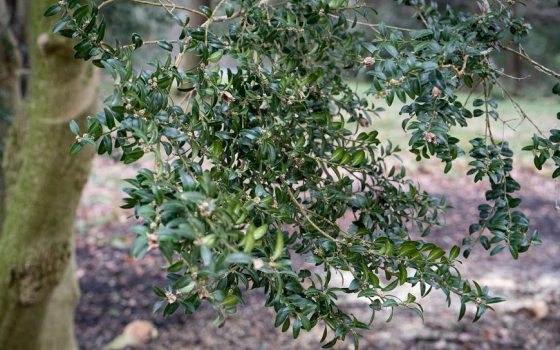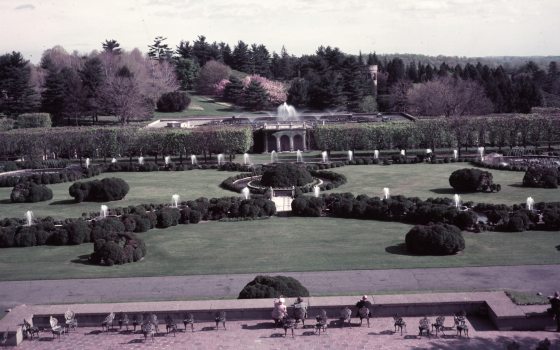While we nurture each and every plant across our Gardens with the utmost care, it is with solemnity that we must say goodbye to a portion of our tree boxwood in the eastern part of our Gardens due to boxwood blight infection. We are especially saddened to see these tree boxwood go, as they represent a portion of our Peirce’s Trees core collection and because boxwood in general are a cornerstone of the French and Italian gardens our founder Pierre S. du Pont strived to replicate here at Longwood.
In August 2020, we discovered boxwood blight—a common fungal infection caused by Calonectria pseudonaviculata that affects boxwood and other plants in the family Buxaceae—on some small seedlings in an area between Flower Garden Walk and Peirce’s Park. Upon our discovery, we immediately contacted the Pennsylvania Department of Agriculture, who came to Longwood and confirmed the disease. Although we have tested for suspected boxwood blight before, this is our first confirmed case here at Longwood, and acted quickly by removing infected plants in August and September. To prevent additional spread, we are temporarily closing a few areas in the eastern portion of our gardens to remove select plants this winter while the disease is dormant, limiting further spread during the process. While removing the affected plant material, staff will be wearing Tyvek suits, which they will remove and safely dispose of when finished working in the area to ensure the disease does not spread. Boxwood blight cannot be spread to humans or animals.

First found in the United Kingdom in the mid-1990s, boxwood blight is throughout Europe and was discovered in the United States in 2011. It is now in 20 states, including Pennsylvania, and active in our area from May through October. Boxwood blight is an easily transmitted disease and one that can kill the host plant. Boxwood blight symptoms begin as dark leaf spots that coalesce to form brown blotches. The undersides of infected leaves will show white sporulation and the plant will lose its leaves quickly, starting in the lower branches and moving upward. Black streaking is also present on the defoliated stems.

Sadly, boxwood blight is not treatable. While fungicides are effective at protecting plants from boxwood blight infection, it does not cure infected plant material. The only way to ensure the disease does not spread is to remove the infected plant material from the landscape. Like many diseases, boxwood blight can spread to other boxwood or plants in the family Buxaceae, including pachysandra and sweet-box.
Unfortunately, Longwood is not alone when it comes to the necessary remediation of boxwood blight. During this removal, we are learning from our global garden partners how best to approach such remediation, listening to such invaluable resources as Château de Villandry (Villandry, France), a 16th castle on the Loire famous for its beautiful Renaissance gardens created by Joachim Carvallo, the great-grandfather of current owner Henri Carvallo. Carvallo has shared with us what he has learned from Villandry’s experience combating boxwood blight, notably pertaining to their multi-year effort of having to replace 10 miles of boxwood in their famed kitchen garden—totaling approximately 100,000 plants—with a resistant Buxus.


To ensure the longevity and health of our collection, we evaluated all boxwood in the Gardens for blight and identified infected plants for removal, along with those nearby to create a buffer zone. Our staff has taken every precaution to mitigate the spread, including limiting access to the area, enacting sanitation protocols, and following integrated pest management best practices. Our goal is to always use the safest method and to avoid chemical use whenever possible. In fact, part of our control protocols is to keep boxwood trimmed back from pathways so that guests do not inadvertently brush the foliage and possibly spread or introduce the disease.
Happily, we are confident the blight is contained in small areas of our eastern gardens and that there is no impact to the Main Fountain Garden or western gardens at this time. The boxwood in the Main Fountain Garden are Japanese boxwood Buxus microphylla var. japonica ‘Green Beauty’, specifically chosen for their increased resistance to boxwood blight compared to other boxwood varieties. As we introduce new boxwood into the Gardens, we are selecting more blight-resistant varieties.

As for our infected plants in the eastern gardens, we are following all necessary protocols recommended above and beyond best practices: removing the infected plant material from the Gardens. After removal, we flame treat the ground in the infected area to kill spores and spread mulch to cover any that might have survived. We will also treat the remaining tree boxwood in the area, which are key to the collection and our Gardens, with a preventative fungicide. Proactively, to decrease the possibility of further spread, we are pruning the bottom branches of all tree boxwood for a 12- to 18-inch ground clearance across the Gardens.
This spring into autumn of 2021, we will introduce new plantings to those areas affected by removal, with the addition of rhododendron and other disease-resistant plants appropriate to the design. While we will miss our beloved boxwood, we know we are acting accordingly and responsibly to protect the health and longevity of the remainder of our robust collection. We also take comfort in the fact that many of Mr. du Pont’s original boxwood plantings are still thriving in our Gardens, hearkening back to the European garden design he so very much cherished.


